Popular categories
Looking for a yarn?

100% Wool
from 3.50 £ /50g
Order DROPS Needles & Hooks
Clicking the ORDER button will redirect you to Wool Warehouse Direct Ltd website
The yarn cost is calculated from the pattern’s smallest size and the yarn’s cheapest product type. Looking for an even better price? You might find it on the DROPS Deals!
Spring Princess
Knitted jumper in a square with lace pattern for baby. Size 1 month - 4 years Piece is knitted in DROPS BabyMerino.
DROPS design: Pattern no bm-081-by
Yarn group A
----------------------------------------------------------
Size: 1/3 - 6/9 - 12/18 months (2 - 3/4) years
Size equivalent to approx. child’s length in cm:
56/62 - 68/74 - 80/86 (92 - 98/104)
Materials:
DROPS BABYMERINO from Garnstudio (belongs to yarn group A)
150-150-200 (200-200) g colour no 44, powder
Piece can also be knitted with yarn from:
“Alternative yarn (yarn group A)” - see link below.
DROPS DOUBLE POINTED NEEDLES AND CIRCULAR NEEDLE (40 cm) SIZE 3 mm – or size needed to get 24 stitches and 34 rows in stocking stitch = width 10 cm and 10 cm vertically.
DROPS CROCHET HOOK SIZE 3 mm - for button strap.
DROPS MOTHER-OF-PEARL BUTTON ARCHED (white), NO 521: 1 piece for all sizes
----------------------------------------------------------
-------------------------------------------------------
Alternative Yarn – See how to change yarns here
Yarn Groups A to F – Use the same pattern and change the yarn here
Yarn usage using an alternative yarn – Use our yarn converter here
-------------------------------------------------------

100% Wool
from 3.50 £ /50g
Order DROPS Needles & Hooks
Clicking the ORDER button will redirect you to Wool Warehouse Direct Ltd website
The yarn cost is calculated from the pattern’s smallest size and the yarn’s cheapest product type. Looking for an even better price? You might find it on the DROPS Deals!
- English (UK/cm)
- Česky
- Dansk
- Deutsch
- Eesti keel
- English (US/in)
- Español
- Français
- Íslenska
- Italiano
- Magyar
- Nederlands
- Norsk
- Polski
- Português
- Suomi
- Svenska
- English (UK/cm), Bulgaria
- English (UK/cm), Croatia
- English (UK/cm), Greece
- English (UK/cm), Latvia
- English (UK/cm), Lithuania
- English (UK/cm), Romania
- English (UK/cm), Slovenia
- Česky, Slovakia
Pattern instructions
GARTER STITCH (back and forth):
1 ridge = knit 2 rows.
GARTER STITCH (worked in the round):
1 ridge = 2 rounds. Knit 1 round and purl 1 round.
PATTERN:
See diagrams A.1 to A.4.
Diagrams show all rows in pattern seen from the right side.
DECREASE TIP (applies to sleeves):
Decrease 1 stitch on each side of marker as follows:
Decrease 1 stitch after marker as follows: Knit 1, slip 1 stitch knitwise, knit 1, pass slipped stitch over (= 1 stitch decreased).
Decrease 1 stitch before marker as follows: Work until 3 stitches remain before marker, knit the next 2 stitches together (= 1 stitch decreased = 2 stitches decreased in total).
----------------------------------------------------------
JUMPER:
Piece is first worked in the round in a square from middle of front piece and out towards neck and sides, then continue back and forth. Work over to back piece, slip shoulder together and work down back piece. Finish with an edge at the bottom of jumper in the round on circular needle. For sleeves pick up stitches, work them top down, in the round on double pointed needles.
FRONT PIECE:
Worked in the round. Cast on 6 stitches on double pointed needles size 3 mm with BabyMerino, switch to circular needle when needed. Knit 1 round. On next round increase as follows: * Knit 1, 1 yarn over *, work from *-* = 12 stitches, knit yarn overs twisted on next round, they should not make holes. Then work A.1 4 times in total, insert 1 marker between every A.1 (= 4 markers). REMEMBER THE KNITTING TENSION! When diagram A.1 has been worked 1 time vertically, there are 204 stitches on needle (= 51 stitches on each of the sides). Piece now measures approx. 24 cm at the widest.
Now cast off for neck as follows:
Work A.2 (= 6 stitches), work 7-6-6 (5-4) stitches in stocking stitch, cast off the next 25-27-27 (29-31) stitches for neck, work 7-6-6 (5-4) stitches in stocking stitch, work A.3 (= 6 stitches), A.2 over the next 6 stitches, * work in stocking stitch until 6 stitches remain before next marker, A.3 over the next 6 stitches, A.2 over the next 6 stitches *, work from *-* 2 times in total, work in stocking stitch until 6 stitches remain before last marker, A.3 over the last 6 stitches, cut the yarn. Displace the round so that next row will start from the neck.
Now work back and forth. Work 10-10-12 (12-16) row in total of A.2, A.3 and stocking stitch. Repeat diagram A.2 and A.3 vertically over the outermost 6 stitches on each side of markers in each corner = 235-233-249 (247-269) stitches. Piece measures approx. approx. 30-30-32 (32-34) cm on the widest.
Now work next row as follows from right side:
Knit 20-19-21 (20-22) (= until 1st marker = right shoulder), knit the next 22-24-26 (29-31) stitches, slip them on a stitch holder (= stitches for right sleeve), cast off the next 43-41-43 (40-44) stitches (= until 2nd marker = right side), knit 65-65-69 (69-75), slip them on a stitch holder (= until 3rd marker = bottom edge. Slip these stitches together with stitch from back piece later and work a lace pattern over these), cast off the next 43-41-43 (40-44) stitches (= left side), knit the next 22-24-26 (29-31) stitches, slip them on a stitch holder (= until 4th marker = stitches for left sleeve), knit the remaining 20-19-21 (20-22) stitches (= left shoulder). Now work back piece over stitches as follows:
BACK PIECE:
LEFT SHOULDER:
Insert 1 marker in piece, NOW MEASURE PIECE FROM HERE! Cast on 1 stitch on next row from wrong side = 21-20-22 (21-23) stitches. Work the new stitch in GARTER STITCH – see explanation above, (pick up stitches for sleeve inside this stitch later). Work 2 cm in stocking stitch with 1 edge stitch in garter stitch towards shoulder, then cast on 13-14-14 (15-16) stitches for neck at the end of next row from right side = 34-34-36 (36-39) stitches. Then work in stocking stitch with 1 edge stitch in garter stitch in each side of piece. When piece measures 8 cm (= 6 cm vent), adjust to finish with 1 row from right side, put piece aside and work right shoulder as follows:
RIGHT SHOULDER:
Work as left shoulder but reversed, i.e. cast on 1 stitch towards sleeve at the end of first row from right side and cast on 13-14-14 (15-16) stitches for neck at the end of row from wrong side. When piece measures 8 cm, adjust to finish with 1 row from right side, work shoulder together as follows:
First work over stitches from right shoulder as follows: Work 1 edge stitch in garter stitch, purl 32-32-34 (34-37), 1 stitch in garter stitch, then work over stitches from left shoulder as follows, 1 stitch in garter stitch, purl 32-32-34 (34-37), 1 edge stitch in garter stitch = 68-68-72 (72-78) stitches. Then work piece in stocking stitch with 1 edge stitch in garter stitch in each side of piece. When piece measures 9-10-11 (12-13) cm cast on 2 new stitch for armholes at the end of the next 2 rows = 72-72-76 (76-82) stitches. Then work piece in stocking stitch over all stitches. Work until back piece measures 30-30-32 (32-34) cm at the longest, adjust measurement according to front piece, back piece and front piece should now be the same length. Keep stitches on needle.
ASSEMBLY:
Sew side seams in outer loops of edge stitches. Then work an edge at the bottom of jumper over stitches from both front and back piece as follows:
BOTTOM EDGE:
Slip stitches from stitch holder at the bottom of front piece onto same circular needle as stitches from back piece = 137-137-145 (145-157) stitches. Now continue in the round. Knit 1 round and increase 7 stitches evenly over front piece = 144-144-152 (152-164) stitches. Work 0-0-0 (3-4) cm in stocking stitch. Then work A.4 over all stitches. Cast off by knitting when A.4 has been worked 1 time vertically. Edge measures approx. 2-2-2 (5-6) cm. Piece measures approx. 32-32-34 (37-40) cm in total from shoulder.
SLEEVE:
Work sleeves in the round on double pointed needles, top down. Slip stitches from stitch holder on front piece in one side on double pointed needles size 3 mm (= 22-24-26 (29-31) stitches) and pick up from right side 22-24-26 (29-31) stitches evenly over back piece inside 1 edge stitch, from shoulder and down to and with where the 2 new stitches were cast on (i.e. pick up approx. 1 stitch in each of the 2 stitches cast on for armhole on back piece) = 44-48-52 (58-62) stitches. Insert 1 marker mid under sleeve. Work in stocking stitch. When sleeve measures 2 cm, decrease 1 stitch on each side of marker - READ DECREASE TIP! Decrease like this every 4-3-2½ (2½-3) cm 3-5-6 (8-9) times in total = 38-38-40 (42-44) stitches. When piece measures 15-18-21 (26-31) cm, work 3 ridges over all stitches. Cast off by knitting. Make sure to avoid a tight cast-off edge, cast off with 1 larger needle size if needed. Sleeve measures approx. 16-19-22 (27-32) cm. Work the other sleeve the same way.
NECK EDGE:
Work piece back and forth from mid back. I.e. pick up stitch from right side from right shoulder on back piece, over front piece and over left shoulder on back piece. Pick up approx. 55 to 74 stitches. Work 3 ridges. Cast off by knitting. Make sure to avoid a tight cast-off edge, cast off with 1 larger needle size if needed.
STRAP:
Now work a strap for buttoning button at the top of neck on back piece. Work 1 slip stitch on left shoulder in last stitch cast on in neck, work 6 chain stitch and finish with 1 slip stitch in same stitch as the first. Fasten off. Sew on button inside 1 edge stitch in garter stitch at the top of neck on back piece on right shoulder.
Diagram

|
= knit from the right side, purl from the wrong side |

|
= purl from the right side, knit from the wrong side |

|
= knit 2 together |

|
= slip 1 stitch knitwise, knit 1, pass slipped stitch over |

|
= between 2 stitches make 1 yarn over, knit yarn over on next round to make a hole |

|
= between 2 stitches make 1 yarn over, knit yarn over twisted on next round, it should NOT make a hole |

|
= between 2 stitches make 1 yarn over, purl yarn over on next round to make a hole |

|
= slip 2 stitches knitwise, knit 1, pass the 2 slipped stitches over |

|
= knitting direction |
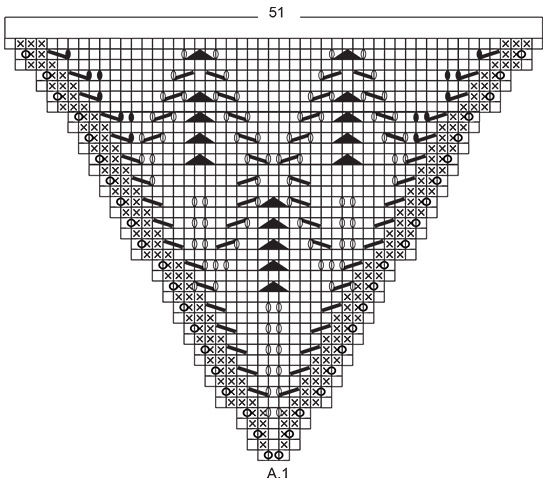
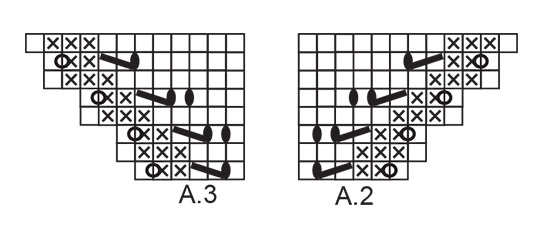
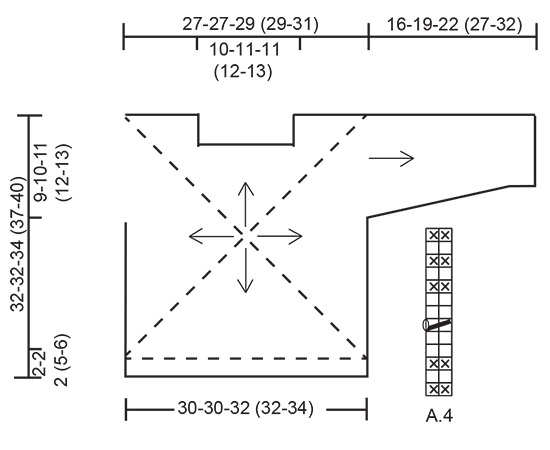
What can you do with our patterns? You can share DROPS patterns online, using the pattern original picture, materials, name and number. But you are NOT ALLOWED to reproduce the complete pattern digitally in any way. Yarn stores are welcome to use the DROPS pattern database to promote the sale of our assortment. You can print out our patterns, make as many copies as you’d like. The only thing we ask is that you don't make any changes / additions to the original printed document. And that the patterns according to the DROPS philosophy are given out to the consumers for free. Editorials that wish to publish our patterns in printed books or magazines can contact us for more information. The sale of garments based on DROPS patterns is permitted as long as they are sold as single items or per order. Further commercial use of the patterns is not permitted. It has to be clearly stated that the garment is made based on a design from DROPS DESIGN. The use of clothing labels of which DROPS DESIGN forms part is conditioned by the inclusion of the following text: “A DROPS DESIGN made by …..”. The use of DROPS photos for marketing purposes/sales is only permitted in connection with the use/sale of DROPS products. The photos may not be cut or edited and the logo should be clearly visible.
We reserve the right to withdraw the permission for use of our patterns at any time, notwithstanding the reason.
Each of our patterns has specific tutorial videos to help you.
These step-by-step tutorials might also help you:
Why is the knitting/crochet tension so important?
Knitting tension is what determines the final measurements of your work, and is usually measured per 10 x 10 cm. It is provided like so: number of stitches in width x number of rows in height - eg: 19 stitches x 26 rows = 10 x 10 cm.
The knitting tension is very individual; some people knit/crochet loosely while others work tightly. You adjust the knitting tension with the needle size, which is why the suggested needle size is only meant as a guide! You need to adjust this (up or down) to ensure that YOUR knitting tension matches the knitting tension provided in the pattern. If you work with a different knitting tension than provided you will have a different yarn consumption, and your work will have different measurements than what the pattern suggests.
The knitting tension also determines which yarns can replace each other. As long as you achieve the same knitting tension you can replace one yarn with another.
See DROPS lesson: How to measure your tension/gauge
See DROPS video: How to make a gauge tension swatch
How do I know how many balls of yarn I need?
The required amount of yarn is provided in grams, eg: 450 g. To calculate how many balls you’ll need you first need to know how many grams are in 1 ball (25g, 50g or 100g). This information is available if you click on the individual yarn quality on our pages. Divide the amount required with the amount of each ball. For example, if each ball is 50g (the most common amount), the calculation will be as follows: 450 / 50 = 9 balls.
Can I use a different yarn than what the pattern suggests?
The important thing when changing from one yarn to another is that the knitting/crochet tension remains the same. This is so that the measurements of the finished piece will be the same as on the sketch provided. It is easier to achieve the same knitting tension using yarns from the same yarn group. It is also possible to work with multiple strands of a thinner yarn to achieve the knitting tension of a thicker one. Please try our yarn converter. We recommend you to always work a test swatch.
Please NOTE: when changing yarn the garment might have a different look and feel to the garment in the photo, due to individual properties and qualities of each yarn.
See DROPS lesson: Can I use a different yarn than the one mentioned in the pattern?
What are the yarn groups?
All our yarns are categorised into yarn groups (from A to F) according to thickness and knitting tension – group A contains the thinnest yarns and group F the thickest. This makes it easier for you to find alternative yarns to our patterns, should you wish to switch yarn. All yarns within the same group have a similar knitting tension and can easily replace each other. However, different yarn qualities have different structures and properties which will give the finished work a unique look and feel.
How do I use the yarn calculator?
At the top of all our patterns you’ll find a link to our yarn calculator, which is a helpful tool should you wish to use a different yarn than suggested. By filling in the yarn quality you wish to replace, the amount (in your size) and number of strands, the calculator will present good alternative yarns with the same knitting tension. Additionally it will tell you how much you’ll require in the new qualities and whether you’ll need to work with multiple strands. Most skeins are 50g (some are 25g or 100g).
If the pattern is worked with multiple colours, every colour will have to be calculated separately. Similarly, if the pattern is worked with several strands of different yarns (for example 1 strand Alpaca and 1 strand Kid-Silk) you will have to find alternatives for each, individually.
Why do you show discontinued yarns in the patterns?
Since different yarns have different qualities and textures we have chosen to keep the original yarn in our patterns. However, you can easily find options among our available qualities by using our yarn calculator, or simply pick a yarn from the same yarn group.
It is possible that some retailers still have discontinued yarns in stock, or that someone has a few skeins at home that they would like to find patterns for.
The yarn calculator will provide both alternative yarn as well as required amount in the new quality.
What size should I knit?
If you think it's hard to decide what size to make, it can be a good idea to measure a garment you own already and like the size of. Then you can pick the size by comparing those measures with the ones available in the pattern's size chart.
You'll find the size chart at the bottom of the pattern.
See DROPS lesson: How to read size chart
Why do I get the wrong knitting tension with the suggested needle size?
The needle size provided in the pattern serves only as a guide, the important thing is to follow the knitting tension. And since knitting tension is very individual, you will have to adjust the needle size to ensure that YOUR tension is the same as in the pattern – maybe you’ll have to adjust 1, or even 2 needle sizes, up or down to achieve the correct tension. For this, we recommend that you work test swatches.
Should you work with a different knitting tension than the one provided, the measurements of the finished garment might deviate from the measurement sketch.
See DROPS lesson: How to measure your tension/gauge
See DROPS video: How to make a tension/gauge swatch
Why is the pattern worked top-down?
Working a garment top-down provides more flexibility and room for personal adjustment. For example it is easier to try the garment on while working, as well as making adjustments to length of yoke and shoulder caps.
The instructions are carefully explaining every step, in the correct order. Diagrams are adjusted to the knitting direction and are worked as usual.
How do I work according to a knitting diagram?
The diagram depicts all rows/rounds, and every stitch seen from the right side. It is read from bottom to top, from right to left. 1 square = 1 stitch.
When working back and forth, every other row is worked from the right side and every other row is worked from the wrong side. When working from the wrong side, the diagram will have to be worked reversed: from left to right, knit stitches are purled, purl stitches are knit etc.
When working in the round every round is worked from the right side and the diagram are worked from right to left on all rounds.
See DROPS lesson: How to read knitting diagrams
How do I work according to a crochet diagram?
The diagram depicts all rows/rounds, and every stitch seen from the right side. It is worked from bottom to top, from right to left.
When working back and forth every other row is worked from the right side: from right to left and every other row is worked from the wrong side: from left to right.
When working in the round, every row in the diagram are worked from the right side, from right to left.
When working a circular diagram you start in the middle and work your way outwards, counter clockwise, row by row.
The rows usually start with a given number of chain stitches (equivalent to the height of the following stitch), this will either be depicted in the diagram or explained in the pattern.
See DROPS lesson: How to read crochet diagrams
How do I work several diagrams simultaneously on the same row/round?
Instructions for working several diagrams after each other on the same row/round, will often be written like so: “work A.1, A.2, A.3 a total of 0-0-2-3-4 times". This means you work A.1 once, then A.2 is worked once, and A.3 is repeated (in width) the number of times provided for your size – in this case like so: S = 0 times, M = 0 times, L=2 times, XL= 3 times and XXL = 4 times.
The diagrams are worked as usual: begin with the first row in A.1, then work the first row in A.2 etc.
See DROPS lesson: How to read knitting diagrams
See DROPS lesson: How to read crochet diagrams
Why are the sleeves shorter in larger sizes?
The total width of the garment (from wrist-to-wrist) will be larger in the larger sizes, despite the actual sleeves being shorter. The larger sizes have longer sleeve caps and wider shoulders, so there will be a good fit in all sizes.
Where on the garment is the length measured?
The measurement sketch/schematic drawing provides information regarding the full length of the garment. If it’s a jumper or a jacket the length is measured from the highest point on the shoulder closest to the neckline, and straight down to the bottom of the garment. It is NOT measured from the tip of shoulder. Similarly, the length of yoke is measured from the highest point on the shoulder and down to where yoke is split into body and sleeves.
On a jacket measures are never taken along bands, unless specifically stated. Always measure inside band stitches when measuring the length.
See DROPS lesson: How to read a schematic drawing
What is a repeat?
Diagrams are often repeated on the round or in height. 1 repeat is the diagram the way it appears in the pattern. If it says to work 5 repeats of A.1 in the round, then you work A.1 a total of 5 times after/next to each other in the round. If it says to work 2 repeats of A.1 vertically/in height you work the entire diagram once, then begin again at the start and work the entire diagram one more time.
Why does the piece start with more chain stitches than it’s worked with?
Chain stitches are slightly narrower than other stitches and to avoid working the cast-on edge too tight, we simply chain more stitches to begin with. The stitch count will be adjusted on the following row to fit the pattern and measurement sketch.
Why increase before the rib edge when the piece is worked top-down?
The rib edge is more elastic and will contract slightly compared to, for example, stocking stitch. By increasing before the rib edge, you avoid a visible difference in width between the rib edge and the rest of the body.
Why increase in the cast-off edge?
It’s very easy to cast off too tightly, and by making yarn overs while casting off (and simultaneously casting these off) you avoid a too tight cast off edge.
See DROPS video: How to bind off with yarn overs (yo)
How do I increase/decrease on every 3rd and 4th row/round alternately?
To achieve an even increase (or decrease) you can increase on, for example: every 3rd and 4th row alternately, like so: work 2 rows and increase on the 3rd row, work 3 rows and increase on the 4th. Repeat this until the increase is complete.
See DROPS lesson: Increase or decrease 1 st on every 3rd and 4th row alternately
How can I work a jacket in the round instead of back and forth?
Should you prefer to work in the round instead of back and forth, you may of course adjust the pattern. You’ll need to add steeks mid-front (usually 5 stitches), and follow the instructions. When you would normally turn and work from the wrong side, simply work across the steek and continue in the round. At the end you’ll cut the piece open, pick up stitches to work bands, and cover the cut edges.
See DROPS video: How to knit steeks and cut open
Can I work a jumper back and forth instead of in the round?
Should you prefer to work back and forth instead of in the round, you may of course adjust the pattern so you work the pieces separately and then assemble them at the end. Divide the stitches for the body in 2, add 1 edge stitch in each side (for sewing) and work the front and back pieces separately.
See DROPS lesson: Can I adapt a pattern for circular needles into straight needles?
Why is the pattern slightly different than what I see in the photo?
Pattern repeats can vary slightly in the different sizes, in order to get the correct proportions. If you’re not working the exact same size as the garment in the photo, yours might deviate slightly. This has been carefully developed and adjusted so that the complete impression of the garment is the same in all sizes.
Make sure to follow instructions and diagrams for your size!
How do I make a women’s size garment into a men’s size one?
If you have found a pattern you like which is available in women’s size it’s not very difficult to convert it to men’s size. The biggest difference will be the length of sleeves and body. Start working on the women size that you think would fit across the chest. The additional length will be worked right before you cast off for the armhole/sleeve cap. If the pattern is worked top-down you can add the length right after the armhole or before the first decrease on sleeve.
Regarding additional yarn amount, this will depend on how much length you add, but it is better with a skein too many than too few.
How do I prevent a hairy garment from shedding?
All yarns will have excess fibres (from production) that might come off as lint or shedding. Brushed yarns (ie hairier yarns) have more of these loose, excess fibres, causing more shedding.
Shedding also depends on what is worn under or over the garment, and whether this pulls at the yarn fibres. It’s therefore not possible to guarantee that there will be no shedding
Below are some tips on how to get the best result when working with hairier yarns:
1. When the garment is finished (before you wash it) shake it vigorously so the looser hairs come off. NOTE: do NOT use a lint roller, brush or any method that pulls at the yarn.
2. Place the garment in a plastic bag and put it in your freezer - the temperature will cause the fibres to become less attached to each other, and excess fibres will come off easier.
3. Leave in the freezer for a few hours before taking it out and shaking it again.
4. Wash the garment according to the instructions on the yarn label.
Why does my garment pill?
Pilling is a natural process that happens to even the most exclusive of fibers. It's a natural sign of wear and tear that is hard to avoid, and that is most visible in high friction areas of your garment like a sweater's arms and cuffs.
You can make your garment look as new by removing the pilling, using a fabric comb or a pill/lint remover.
In the meantime, you can read the questions and answers that others have left to this pattern or join the DROPS Workshop on Facebook to get help from fellow knitters/crocheters!
You might also like...
Spring Princess
b31-13 Spring Princess
Spring Princess
Phocas spring princess
Spring Princess |
||||||||||||||||||||||||||||
 |
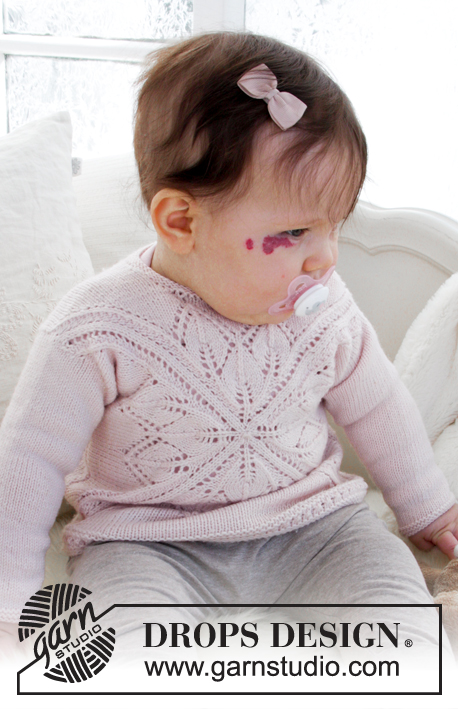 |
|||||||||||||||||||||||||||
Knitted jumper in a square with lace pattern for baby. Size 1 month - 4 years Piece is knitted in DROPS BabyMerino.
DROPS Baby 31-13 |
||||||||||||||||||||||||||||
|
INFORMATION FOR PATTERN: GARTER STITCH (back and forth): 1 ridge = knit 2 rows. GARTER STITCH (worked in the round): 1 ridge = 2 rounds. Knit 1 round and purl 1 round. PATTERN: See diagrams A.1 to A.4. Diagrams show all rows in pattern seen from the right side. DECREASE TIP (applies to sleeves): Decrease 1 stitch on each side of marker as follows: Decrease 1 stitch after marker as follows: Knit 1, slip 1 stitch knitwise, knit 1, pass slipped stitch over (= 1 stitch decreased). Decrease 1 stitch before marker as follows: Work until 3 stitches remain before marker, knit the next 2 stitches together (= 1 stitch decreased = 2 stitches decreased in total). ---------------------------------------------------------- JUMPER: Piece is first worked in the round in a square from middle of front piece and out towards neck and sides, then continue back and forth. Work over to back piece, slip shoulder together and work down back piece. Finish with an edge at the bottom of jumper in the round on circular needle. For sleeves pick up stitches, work them top down, in the round on double pointed needles. FRONT PIECE: Worked in the round. Cast on 6 stitches on double pointed needles size 3 mm with BabyMerino, switch to circular needle when needed. Knit 1 round. On next round increase as follows: * Knit 1, 1 yarn over *, work from *-* = 12 stitches, knit yarn overs twisted on next round, they should not make holes. Then work A.1 4 times in total, insert 1 marker between every A.1 (= 4 markers). REMEMBER THE KNITTING TENSION! When diagram A.1 has been worked 1 time vertically, there are 204 stitches on needle (= 51 stitches on each of the sides). Piece now measures approx. 24 cm at the widest. Now cast off for neck as follows: Work A.2 (= 6 stitches), work 7-6-6 (5-4) stitches in stocking stitch, cast off the next 25-27-27 (29-31) stitches for neck, work 7-6-6 (5-4) stitches in stocking stitch, work A.3 (= 6 stitches), A.2 over the next 6 stitches, * work in stocking stitch until 6 stitches remain before next marker, A.3 over the next 6 stitches, A.2 over the next 6 stitches *, work from *-* 2 times in total, work in stocking stitch until 6 stitches remain before last marker, A.3 over the last 6 stitches, cut the yarn. Displace the round so that next row will start from the neck. Now work back and forth. Work 10-10-12 (12-16) row in total of A.2, A.3 and stocking stitch. Repeat diagram A.2 and A.3 vertically over the outermost 6 stitches on each side of markers in each corner = 235-233-249 (247-269) stitches. Piece measures approx. approx. 30-30-32 (32-34) cm on the widest. Now work next row as follows from right side: Knit 20-19-21 (20-22) (= until 1st marker = right shoulder), knit the next 22-24-26 (29-31) stitches, slip them on a stitch holder (= stitches for right sleeve), cast off the next 43-41-43 (40-44) stitches (= until 2nd marker = right side), knit 65-65-69 (69-75), slip them on a stitch holder (= until 3rd marker = bottom edge. Slip these stitches together with stitch from back piece later and work a lace pattern over these), cast off the next 43-41-43 (40-44) stitches (= left side), knit the next 22-24-26 (29-31) stitches, slip them on a stitch holder (= until 4th marker = stitches for left sleeve), knit the remaining 20-19-21 (20-22) stitches (= left shoulder). Now work back piece over stitches as follows: BACK PIECE: LEFT SHOULDER: Insert 1 marker in piece, NOW MEASURE PIECE FROM HERE! Cast on 1 stitch on next row from wrong side = 21-20-22 (21-23) stitches. Work the new stitch in GARTER STITCH – see explanation above, (pick up stitches for sleeve inside this stitch later). Work 2 cm in stocking stitch with 1 edge stitch in garter stitch towards shoulder, then cast on 13-14-14 (15-16) stitches for neck at the end of next row from right side = 34-34-36 (36-39) stitches. Then work in stocking stitch with 1 edge stitch in garter stitch in each side of piece. When piece measures 8 cm (= 6 cm vent), adjust to finish with 1 row from right side, put piece aside and work right shoulder as follows: RIGHT SHOULDER: Work as left shoulder but reversed, i.e. cast on 1 stitch towards sleeve at the end of first row from right side and cast on 13-14-14 (15-16) stitches for neck at the end of row from wrong side. When piece measures 8 cm, adjust to finish with 1 row from right side, work shoulder together as follows: First work over stitches from right shoulder as follows: Work 1 edge stitch in garter stitch, purl 32-32-34 (34-37), 1 stitch in garter stitch, then work over stitches from left shoulder as follows, 1 stitch in garter stitch, purl 32-32-34 (34-37), 1 edge stitch in garter stitch = 68-68-72 (72-78) stitches. Then work piece in stocking stitch with 1 edge stitch in garter stitch in each side of piece. When piece measures 9-10-11 (12-13) cm cast on 2 new stitch for armholes at the end of the next 2 rows = 72-72-76 (76-82) stitches. Then work piece in stocking stitch over all stitches. Work until back piece measures 30-30-32 (32-34) cm at the longest, adjust measurement according to front piece, back piece and front piece should now be the same length. Keep stitches on needle. ASSEMBLY: Sew side seams in outer loops of edge stitches. Then work an edge at the bottom of jumper over stitches from both front and back piece as follows: BOTTOM EDGE: Slip stitches from stitch holder at the bottom of front piece onto same circular needle as stitches from back piece = 137-137-145 (145-157) stitches. Now continue in the round. Knit 1 round and increase 7 stitches evenly over front piece = 144-144-152 (152-164) stitches. Work 0-0-0 (3-4) cm in stocking stitch. Then work A.4 over all stitches. Cast off by knitting when A.4 has been worked 1 time vertically. Edge measures approx. 2-2-2 (5-6) cm. Piece measures approx. 32-32-34 (37-40) cm in total from shoulder. SLEEVE: Work sleeves in the round on double pointed needles, top down. Slip stitches from stitch holder on front piece in one side on double pointed needles size 3 mm (= 22-24-26 (29-31) stitches) and pick up from right side 22-24-26 (29-31) stitches evenly over back piece inside 1 edge stitch, from shoulder and down to and with where the 2 new stitches were cast on (i.e. pick up approx. 1 stitch in each of the 2 stitches cast on for armhole on back piece) = 44-48-52 (58-62) stitches. Insert 1 marker mid under sleeve. Work in stocking stitch. When sleeve measures 2 cm, decrease 1 stitch on each side of marker - READ DECREASE TIP! Decrease like this every 4-3-2½ (2½-3) cm 3-5-6 (8-9) times in total = 38-38-40 (42-44) stitches. When piece measures 15-18-21 (26-31) cm, work 3 ridges over all stitches. Cast off by knitting. Make sure to avoid a tight cast-off edge, cast off with 1 larger needle size if needed. Sleeve measures approx. 16-19-22 (27-32) cm. Work the other sleeve the same way. NECK EDGE: Work piece back and forth from mid back. I.e. pick up stitch from right side from right shoulder on back piece, over front piece and over left shoulder on back piece. Pick up approx. 55 to 74 stitches. Work 3 ridges. Cast off by knitting. Make sure to avoid a tight cast-off edge, cast off with 1 larger needle size if needed. STRAP: Now work a strap for buttoning button at the top of neck on back piece. Work 1 slip stitch on left shoulder in last stitch cast on in neck, work 6 chain stitch and finish with 1 slip stitch in same stitch as the first. Fasten off. Sew on button inside 1 edge stitch in garter stitch at the top of neck on back piece on right shoulder. |
||||||||||||||||||||||||||||
Diagram explanations |
||||||||||||||||||||||||||||
|
||||||||||||||||||||||||||||

|
||||||||||||||||||||||||||||

|
||||||||||||||||||||||||||||

|
||||||||||||||||||||||||||||
|
Have you made this or any other of our designs? Tag your pictures in social media with #dropsdesign so we can see them! Do you need help with this pattern?You'll find tutorial videos, a Comments/Questions area and more by visiting the pattern on garnstudio.com. © 1982-2024 DROPS Design A/S. We reserve all rights. This document, including all its sub-sections, has copyrights. Read more about what you can do with our patterns at the bottom of each pattern on our site. |
||||||||||||||||||||||||||||
With over 40 years in knitting and crochet design, DROPS Design offers one of the most extensive collections of free patterns on the internet - translated to 17 languages. As of today we count 304 catalogues and 11422 patterns - 11422 of which are translated into English (UK/cm).
We work hard to bring you the best knitting and crochet have to offer, inspiration and advice as well as great quality yarns at incredible prices! Would you like to use our patterns for other than personal use? You can read what you are allowed to do in the Copyright text at the bottom of all our patterns. Happy crafting!







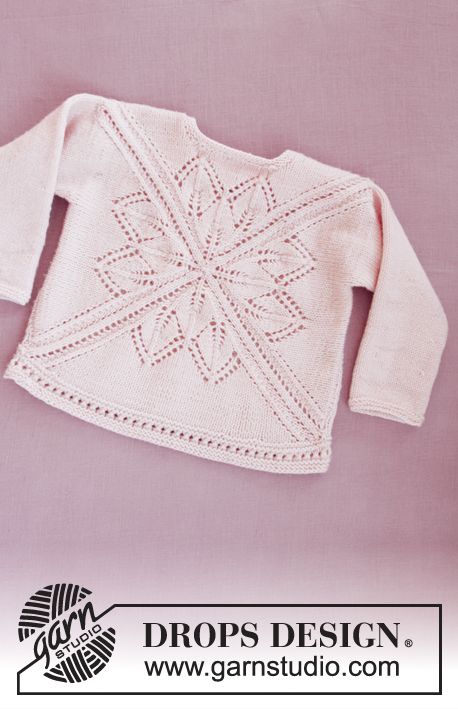

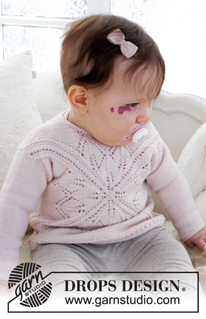







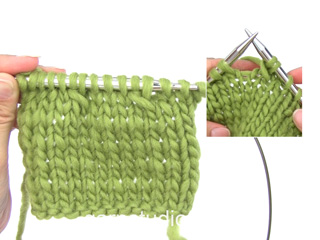









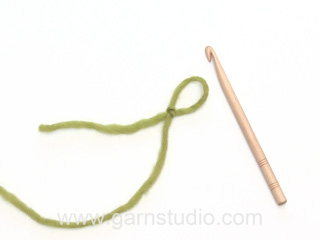



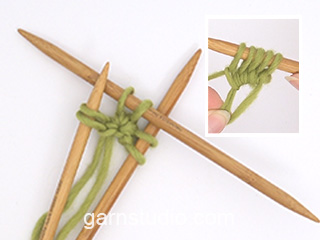





































Comments / Questions (19)
Very beautiful paatern and comes out very well
27.02.2022 - 12:23Bonjour, J'ai réalisé l'échantillon comme conseillé, pour obtenir 10cm en largeur pour 24 mailles, j'ai dû utiliser des aiguilles 4,5 (j'ai vu dans les commentaires que vous conseillé d'augmenter de tailles d'aiguilles jusqu'à obtenir le bon nombre de centimètres) seulement, du coup, avec 34 rangs, je me retrouve avec 12cm de longueur... Comment faire s'il vous plaît ? Merci par avance, Elisa
27.11.2021 - 16:47DROPS Design answered:
Bonjour Elisa, vous tricotez Baby Merino? Tricotez un peu plus serré (cf nuancier) puis lavez et faites sécher votre échantillon (= bloquez-le), puis mesurez- le à nouveau. Si vos mesures en hauteur/largeur ne sont pas juste, ajustez la taille des aiguilles et essayez à nouveau. Dans ce type de modèle, il est important que la hauteur soit tout aussi juste que la largeur. Votre magasin pourra vous conseiller et aura des astuces pour vous - n'hésitez pas à le contacter, même par mail ou téléphone. Bon tricot!
29.11.2021 - 07:42Hei! Olen neulomassa tätä paitaa kohdassa jossa pääntien silmukat on päätelty ja työtä jatketaan tasona. En kuitenkaan ymmärrä kuinka neulotaan 10 kerrosta mallikertoja A2 ja A3, sillä näiden kuvioiden ohjeissa on vain 8 kerrosta ruutupiirrosta.
24.03.2021 - 15:18DROPS Design answered:
Piirrosten A.2 ja A.3 mallikertoja jatketaan kuten aiemmin, eli pitsikuvio siirtyy koko ajan kohti reunoja kuten aiemmin.
24.03.2021 - 16:34Schema bellissimo lo sto realizzando per la mia bimba di sei mesi. è disponibile un disegno simile anche per adulti? Grazie mille
07.01.2021 - 17:12DROPS Design answered:
Buonasera Mariacristina, nello specifico lo stesso disegno non c'è per adulti ma questi due modelli hanno un motivo molto simile: 170-4 e 170-3. Buon lavoro!
07.01.2021 - 17:27Hallo. Die Frage gab es schon auf Englisch , aber ich konnte die Antwort nicht komplett übersetzen. Ich habe das Quadrat gestrickt. Habe abgekettet und bin einmal rum. Ich verstehe das gerade an der Stelle nicht wo ich A.3 gestrickt habe und dann den Faden abschneiden soll. Warum schneide ich den Faden ab? Und soll ich dann an der Ecke umdrehen oder soll ich noch A.2 und die Maschen bis zum angeketteten Stück stricken und dann umdrehen? Danke für sie Antwort im Vorraus
21.05.2020 - 23:31DROPS Design answered:
Liebe Anna, am Anfang der vorrigen Runden haben Sie einige Maschen gestrickt, bevor Sie die Maschen abgekettet haben. Wenn diese Runde bis zur Ende gestrickt ist muss der Faden geschnitten sein, und jetzt in Reihen stricken, dh die Reihen beginnen jetzt links von den abgeketteten Maschen (Rückreihe), damit Sie alle Maschen von der Rückseite stricken können. Viel Spaß beim stricken!
22.05.2020 - 10:06I knit the initial square, bound off for the neck, & reattached the yarn. Do I start the first back and forth row by knitting the 7 stockinette stitches or the A.2 diagram? When I have completed the 10 rows for the smallest size, do I then work the A.2 & A.3 diagrams again? It seems like at this point I will have already worked the diagrams on the outermost 6 stitches of the corners of the square. Thanks for the clarification.
01.08.2019 - 21:39DROPS Design answered:
Dear Mrs Jestis, after you have worked the rows casting off the stitches for neck, cut the yarn, then turn (= next row will be worked from WS) and join yarn after the stitches cast off for neck, starting with the 7 sts in stocking st, then A.3, A.2 and so on to the 7 sts in stocking st at the end of the row. this means you are now working along the 4 sides of the square but starting from one side of neck to the other side of neck. Work a total of 10 rows inA.2/A.3. Happy knitting!
07.08.2019 - 09:31I would like to congratulate you on your site.I knit continuously, and I would like you to know that yours is the the most professional, friendly, easy and generous site I have used.You have lots of interesting patterns, but more than that, I am able to download them.So many sites demand signup before you can even look at patterns.You cater to language and size change between countries...Thank you.I am VERY happy to recommend you to other knitters.Keep up the great site...and be proud.
13.07.2019 - 05:47Hi, I am making the DROPS Baby31-13 sweater with the drops baby merino yarn. I’ve made several swatches & my gauge is wrong. I swatched with US size 4 (3.5mm) & 5 (3.75mm). My gauges are 27 st x 36.75 rows(size 4) and 26.25 st x 32.5 rows (size 5) after washing & blocking a 6” square. You are calling for 24 st x 34 rows. For this, I’ll need to go up to size 6 or 7 and then my row gauge will be all wrong. Is the pattern gauge correct? How can I figure out what I am doing wrong?
14.06.2019 - 17:13DROPS Design answered:
Dear Mrs Jestis, you should try with larger needles, you might work somewhat tight - read more about tension here. Happy knitting!
17.06.2019 - 09:25Die Anleitung lässt sich nicht vollständig ausdrucken, es wird nur eine Seite gedruckt.
30.03.2019 - 09:53DROPS Design answered:
Liebe Renate, alle Seiten sollten ausgedruckt werden, prüfen Sie mal die Druckeinstellungen, damit alle Seiten gedruckt werden. Viel Spaß beim stricken!
01.04.2019 - 12:07Hej. Jeg er igang med den skønne Spring Princess sweater, men er nu jeg gået i stå. Jeg har strikket A.1 en gang i højden og har 204 masker på pinden. I følge opskriften skal jeg nu lukke af til hals - når jeg har gjort det, hvor mange masker skal der så være på pinden? Jeg spørger fordi jeg ikke kan få det til at passe med det antal masker jeg skal have tilbage efter at have strikket 12 pinde af diagram A.2, A.3 og glatstrik i højden over de yderste 6 masker (247 m).
19.02.2019 - 15:00